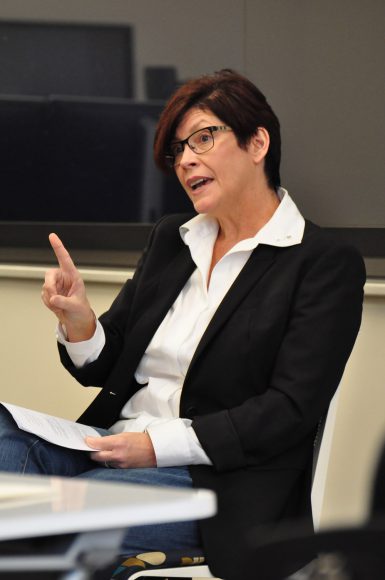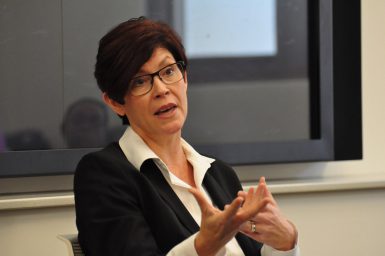Major discusses framing as tool to improve public understanding

How a story is framed plays a key role in public understanding—and, more important, public policy—of the topics it contains, according to associate professor Lesa Hatley Major. This framing leads to how readers attribute responsibility to problems.
Major explained these topics that also are part of her current book project at The Media School’s weekly research talk Nov. 11.
“Think about it with this election that we just had, how the media or individuals define problems. How they think about who caused them, and how they think about who or what will solve them, is critical to public policy and to media coverage,” Major said. “Attribution of responsibility is critical in terms of social issues.”
She said her consideration of the topic led to her thinking about how news and media framing could influence how people view problems and seek out causes and solutions for them.
Framing falls into two main categories: Thematic, focused on a larger trend, and episodic, highlighting an individual. Research into these two types of framing is critical because public policy is directly influenced by how people read and understand issues of blame and responsibility.
“If you’re looking for public support, policy usually doesn’t succeed unless we have public support for it,” Major said.
Major hopes to better understand readers’ responses to thematic and episodic framing through her research, which led to a grant to write her book on the topic.
“We may be able to start looking at different issues, different frames, and say, ‘Here’s what we know across these issues about how people might respond if you use these kinds of frames,’” she said. “So now, long story short, I have a contract to do a book looking at the past 25 years of attribution of responsibility research and news media.”

Associate professor Tony Fargo pointed out that journalists—people who hold a considerable amount of control in how the public understands societal issues—may be hesitant to “frame” a story with any kind of angle or agenda.
“The people trying to go for public policy are one side of the coin; journalists are the other,” he said. “I can picture you talking to a group of journalists about this, about framing their stories differently, and they’d go, ‘I don’t frame stories. It’s not my job to advocate.’ I’m just wondering if you’d had any experience talking to journalists about how to do this and what their response actually has been.”
Major agreed with his concern and explained part of her explanation process in communicating with journalists.
“The whole point of journalism is for us to get information to the public so they can make educated decisions,” she said. “If you’re only covering individuals and getting that out, is that giving the public what they need?”
Major’s research has found success so far with some of those most closely in control of public health and wellness issues. The Center for Disease Control and Prevention has supported her work in improving communication of health issues.
“It’s wonderful when the people out there trying to do this are looking at you going, ‘Thank you, we need more people doing this,’” she said.

